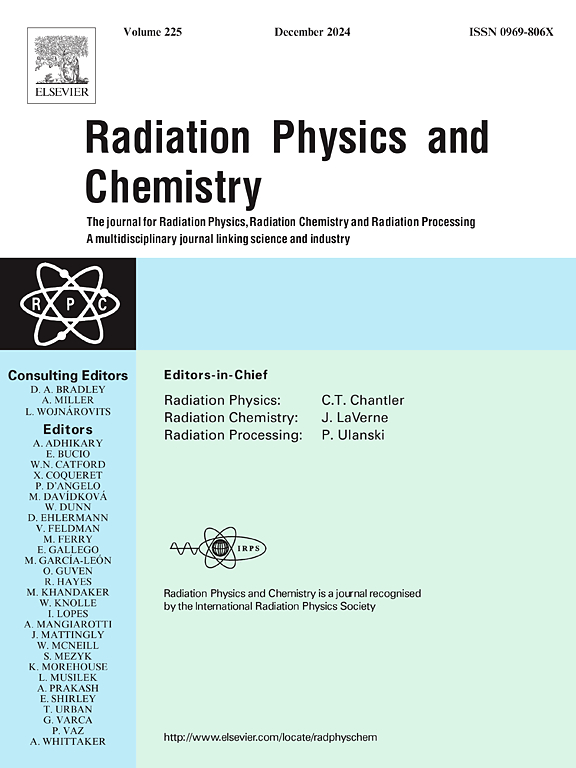Effect of irradiation on ethylene propylene diene monomer doped with different concentrations of wheat husk fiber
IF 2.8
3区 物理与天体物理
Q3 CHEMISTRY, PHYSICAL
引用次数: 0
Abstract
The free volume of ethylene-propylene-diene monomer (EPDM) rubber reinforced with wheat husk fibers (WHFs) was investigated using positron annihilation lifetime (PAL) spectroscopy. The impact of the reinforced WHF concentrations in the range of 0–50 phr on the free volume structure of EPDM/WHF composites is quantified, along with the effect of γ-irradiation doses from 0 to 300 kGy. The swelling coefficient of the toluene, benzene, and chloroform solvents was also determined. The trends of the free volume size and the swelling coefficient with irradiation dosage for all the samples are comparable. The dielectric properties of the investigated composites have been studied, and their conductivity have been calculated. It was found that at low frequencies, the dielectric constant with irradiation dose shows a slight increase while it appears constant at high frequencies. The AC conductivity showed a frequency-dependent increase, indicating enhanced charge carrier mobility. The influence of irradiation dose on AC conductivity varied, with a slight decrease at high frequencies and a slight increase at low frequencies. The conduction mechanisms were found to be quantum mechanical tunneling and correlated barrier hopping, depending on the composite and irradiation dose. Additionally, the nanoscopic properties derived from PAL spectroscopy are correlated with the macroscopic properties of the composites.
辐照对不同浓度麦壳纤维掺杂乙丙二烯单体的影响
利用正电子湮没寿命(PAL)光谱研究了小麦壳纤维增强EPDM橡胶的自由体积。定量研究了0 ~ 50 phr范围内增强WHF浓度对EPDM/WHF复合材料自由体积结构的影响,以及0 ~ 300 kGy γ辐照剂量的影响。测定了甲苯、苯和氯仿溶剂的溶胀系数。所有样品的自由体积大小和膨胀系数随辐照剂量的变化趋势具有可比性。研究了复合材料的介电性能,并计算了其电导率。在低频时,介电常数随辐照剂量略有增加,而在高频时介电常数基本不变。交流电导率显示出频率依赖性的增加,表明电荷载流子迁移率增强。辐照剂量对交流电导率的影响各不相同,在高频时略有降低,在低频时略有增加。根据复合材料和辐照剂量的不同,其传导机制为量子力学隧穿和相关势垒跳变。此外,从PAL光谱中得到的纳米性能与复合材料的宏观性能相关。
本文章由计算机程序翻译,如有差异,请以英文原文为准。
求助全文
约1分钟内获得全文
求助全文
来源期刊

Radiation Physics and Chemistry
化学-核科学技术
CiteScore
5.60
自引率
17.20%
发文量
574
审稿时长
12 weeks
期刊介绍:
Radiation Physics and Chemistry is a multidisciplinary journal that provides a medium for publication of substantial and original papers, reviews, and short communications which focus on research and developments involving ionizing radiation in radiation physics, radiation chemistry and radiation processing.
The journal aims to publish papers with significance to an international audience, containing substantial novelty and scientific impact. The Editors reserve the rights to reject, with or without external review, papers that do not meet these criteria. This could include papers that are very similar to previous publications, only with changed target substrates, employed materials, analyzed sites and experimental methods, report results without presenting new insights and/or hypothesis testing, or do not focus on the radiation effects.
 求助内容:
求助内容: 应助结果提醒方式:
应助结果提醒方式:


